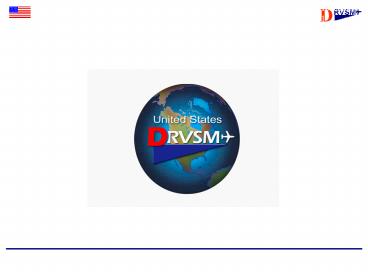RVSM NonGroup Certification Process - PowerPoint PPT Presentation
1 / 13
Title:
RVSM NonGroup Certification Process
Description:
Non-Group Airframe ... Airframes for which a Group certification does not exist ' ... Configuration design alterations that may constitute Non-Group status include: ... – PowerPoint PPT presentation
Number of Views:208
Avg rating:3.0/5.0
Title: RVSM NonGroup Certification Process
1
Presentation 11
Non-Group RVSMCertification Process
Tony Wiederkehr FAA DER - Flight Analyst
2
Non-Group RVSM Certification Presentation Topics
- Definition of the Non-Group Airframe
- Aircraft Systems Configuration
- Flight Testing
- RVSM ASE Requirements
- Data Package Development
- Operator Approval
- Advantages/Disadvantages of the Non-Group
approval, - compared to a Group Approval
- RVSM Non-Group Approval Flowchart
2
3
Definition of a RVSM Non-Group Airframe
If an airframe (meets) the (following)
conditions, or is presented as an individual
airframe for approval, then it must be considered
as a non-group aircraft for the purposes of RVSM
approval.
- Aircraft has been modified such that the basic
(certified nominal) aerodynamic design has been
altered - The static system of the aircraft differs from
the original production or Group standard - The avionics units installed varies significantly
from the production or Group standard - Airframes for which a Group certification does
not exist
3
4
Airframe Specification forNon-Group Certification
- Configuration design alterations that may
constitute Non-Group status include - Fuselage configuration modifications (fairings,
belly tanks, etc.) - Wing modifications
- Engine modifications
- Avionics components
- Unique air data, autopilot or altitude alert
configurations - Static pressure system
- Static source location different from nominal
design
4
5
Dual STCs May Be Required for Non-group Aircraft
- One STC for the avionics upgrade/installation
- One STC for RVSM certification of the retrofitted
airframe - STC for system installation/configuration
- Two independent altimetry systems, one automatic
altitude control system, one altitude alert
system and altitude reporting transponder
(required by 91.215) - System installation must meet FAR Part 25.13XX or
part 23.13XX, as applicable - Normal STC process used for certification of
equipment modifications and upgrades
5
6
Dual STCs for Non-group Aircraft (continued)
- STC for RVSM Certification
- RVSM STC establishes that the upgraded avionics
systems meet Part 91 Appendix G, Section 2
performance tolerances - RVSM STC establishes airframe configuration
requirements for initial and continued
airworthiness - RVSM STC substantiation includes flight testing,
data analysis (in accordance with 91-RVSM),
development of maintenance instructions (FAR Part
25 Appendix H) and development of RVSM Airplane
Flight Manual Supplement - RVSM STC requires accomplishment of the
installation STC
6
7
Aircraft Systems
- RVSM Configuration and Performance
Requirements - Two independent altitude measurement systems
(meeting RVSM altimetry system error ASE
requirements) - One automatic altitude control system (65 ft)
- One altitude alert system (300 ft / 50 ft)
- One SSR altitude reporting transponder
- RVSM-compliant avionics configuration
- Compliance
- Flight testing
- Equipment manufacturers specification data
- Bench testing
7
8
RVSM ASE Requirements
- Requirement
- Group Airplanes
- Non-Group Airplanes
8
9
Flight Testing
- Trailing cone/calibrated chase plane
- Downtime 3 - 5 days, weather dependent
- Simple data acquisition system
- Monitor performance of
- Air Data, Autopilot and
- Altitude Alert systems during
- normal operation
- Airframe/static system inspections conducted
concurrent with flight test activity - RVSM avionics configuration not always required
for flight testing (airframe dependent)
9
10
RVSM Data Package
- Substantiating data for RVSM STC
- compiled into a certification
- data package, including all analysis
- and substantiation for the
- configuration and performance of
- the RVSM-specific aircraft systems
- Instructions for Initial Continued
Airworthiness (IICA) are developed and
substantiated through the RVSM analysis process - Airplane Flight Manual Supplement (AFMS) produced
as required - Top Level RVSM Supplemental Type Certificate
(STC) provided to the operator with IICA and AFMS
documents
10
11
RVSM Operator Approval
- Operator should meet with local aviation
authorities after flight test is completed (60
days typically required) - After receipt of the RVSM STC, operator should
develop a plan to show compliance with STC
instructions - Perform Initial airworthiness maintenance
instructions, and develop a plan for continued
airworthiness compliance - RVSM Pilot training
- Coordinate all tasks closely with the local
authority to secure Letter of Authorization (LOA)
11
12
Advantages/Disadvantagesin comparison to a Group
Certification
- Advantages
- Non-Group RVSM ASE requirements often favorable
for individual airframes - Flight test results may be used to satisfy
monitoring requirements - Fewer avionics updates and/or static system
changes may be necessary for RVSM compliance - Operator has more options for aircraft systems
modifications - Airframe-specific, customized maintenance
requirements - Disadvantages
- All Non-Group aircraft must be flight tested
- An airworthiness certification program must be
completed for each airframe - Operator is free to choose the approval path for
a specific airframe (Group or Non-Group)
12
13
Non-Group Certification Flowchart
N
Avionics components and configuration
Y
Project Planning
Flight Test
Instructions for Initial/Continued Airworthiness
AFMS
Analytical evaluation of altimetry system
N
Airworthiness Approval
N
Operator complies with STC requirements
Data package STC approved?
13































